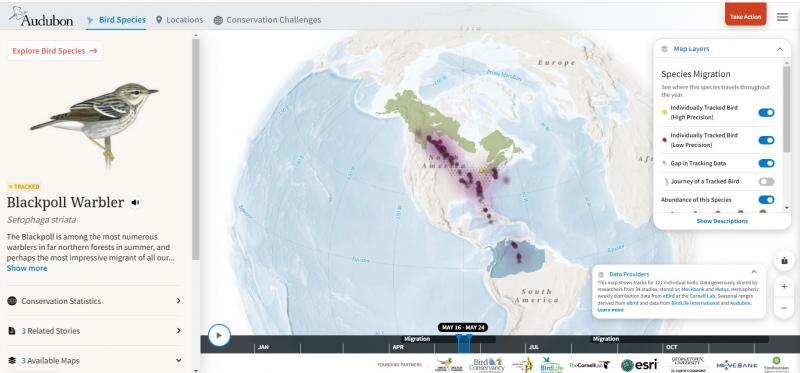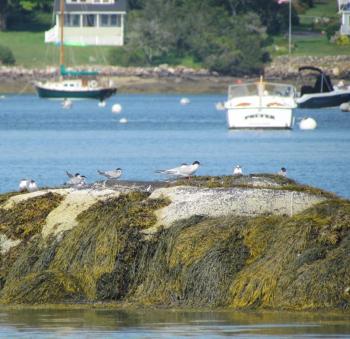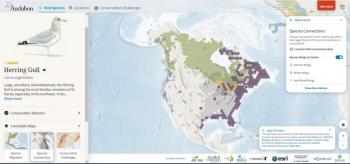How often have you watched a little warbler flitting in the backyard shrubbery and wondered where that bird had come from—and where it might be going next? Or have you noticed the sudden appearance of gulls or ducks in the bay or at your favorite pond and pondered the mysteries of their movements? Do you think about where that osprey whose nest you watch every year may spend its winters?
A new online bird migration atlas called the Bird Migration Explorer, (birdmigrationexplorer.org) released last week by the National Audubon Society and nine founding partner organizations, now lets you answer these and many other questions as you delve into the details of the migratory movements of over 400 bird species. This revolutionary web-based platform brings together migratory tracking data from hundreds of individual studies—the largest compendium ever assembled—combines them with eBird maps modeled from millions of observer records, and displays them using leading-edge, colorful animated maps.
The Bird Migration Explorer took years to build with a large team of scientists, programmers, mappers, designers, writers, and others. It’s easy to use and visually stunning, making it fascinating not only for the avid bird enthusiast but even for those with a mild passing interest.
And kids will love it.
Our eyes were certainly opened to more than we expected when we tried the Bird Migration Explorer for the first time.
We were enthralled in the Bird Migration Explorer to see the movements of common terns from Maine arriving on the shores of northern South America even by mid-August, some continuing farther to southern South America. In contrast, Gulf of Maine breeding Arctic terns are shown traversing in fall across the Atlantic and the globe to Africa and south into sub-Antarctic waters before their spring return.
Tracking data from ring-billed gulls that breed in the St. Lawrence River of Quebec shows their late-summer movements into Maine and the eventual exodus of most of them south from New Jersey to Florida by late December.
We challenge anyone not to be completely blown away by the animated map showing the migrations of tracked blackpoll warblers from their Canadian and New England breeding range to their northern South American wintering range.
Did you know that herring gulls from Midcoast Maine have been found as far north as northern Hudson Bay, south to northern Mexico and Florida, and west to north Texas?
Consider this: a common redpoll banded in Maine was recovered near the Arctic National Wildlife Refuge on the North Slope of Alaska more than 3,000 miles away!
Did you know that more than 8,000 banded or tracked birds connect Maine to at least 16 other countries across the hemisphere? These Maine bird connections range from three snow geese 2,000 miles to the north in High Arctic Canada to a blackpoll warbler 3,500 miles to the south in Yaquerana, Peru!
We didn’t know these facts either until we discovered them using the Bird Migration Explorer.
Talk about making the point that the future of the birds that we all love is a shared responsibility with people and nations across the word!
Along with wowing people with these amazing bird migration stories and connections, the Bird Migration Explorer and the datasets behind it should prove invaluable in guiding future bird conservation efforts. We hope it will also be an inspiration reminding world leaders at the upcoming United Nations Convention on Biological Diversity meeting in Montreal in December of the need to raise their collective ambitions and increase national funding commitments and other efforts to protect our planet.
Try out the Bird Migration Explorer at: birdmigrationexplorer.org
Jeffrey V. Wells, Ph.D., is a Fellow of the Cornell Lab of Ornithology and Vice President of Boreal Conservation for National Audubon. Dr. Wells is one of the nation's leading bird experts and conservation biologists and author of the “Birder’s Conservation Handbook.” His grandfather, the late John Chase, was a columnist for the Boothbay Register for many years. Allison Childs Wells, formerly of the Cornell Lab of Ornithology, is a senior director at the Natural Resources Council of Maine, a nonprofit membership organization working statewide to protect the nature of Maine. Both are widely published natural history writers and are the authors of the popular books, “Maine’s Favorite Birds” (Tilbury House) and “Birds of Aruba, Bonaire, and Curaçao: A Site and Field Guide,” (Cornell University Press).































